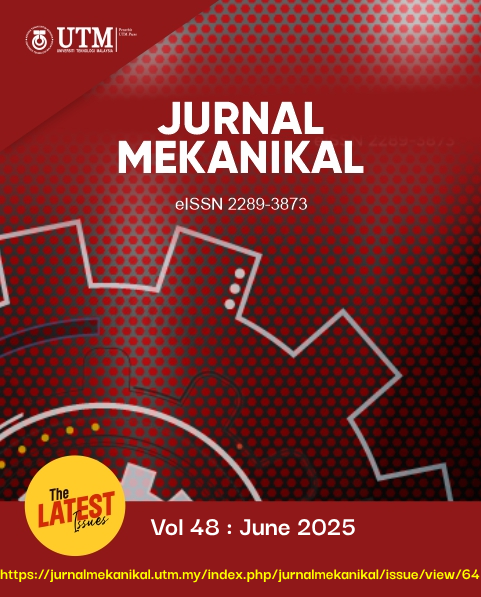Evaluation of Marker and Markerless Augmented Reality (AR) Apps in Enhancing Learning Towards Training for Welding Process
DOI:
https://doi.org/10.11113/jm.v48.562Keywords:
ding, Training, Augmented Reality, Emerging technologies.Abstract
Welding plays an essential role in the development and fabrication of specific metals that must be joined perfectly. It is widely used all around the world and comes in handy in manufacturing, automotive, aerospace, and construction. Therefore, specialized workers are required for the welding process. Unfortunately, it is also a very dangerous process, and many accidents have been reported regarding welding-related injuries. Thus, this study aims to design and develop Augmented Reality apps as learning tools for welding processes and evaluate these AR app. The SOLIDWORKS, BLENDER and UNITY software were used in the design and development process of the AR apps. The evaluation of AR Apps was done by 20 students with Diploma in mechanical engineering part 3 from UITM’ Pulau Pinang. Results gathered showed that the average Task Completion Time (TCT) for the AR Marker group was better (28.37% lower) compared to the AR Markerless group. Moreover, participants also gave positive feedback on learning through both AR apps, which are more efficient in aspects of accuracy, performance, and stability. Therefore, the implementation of AR apps will benefit new users who experience new processes earlier before having actual processes or machines. Also, this new technology will be expanded and used in any field of study, including education and other industries.
References
Golovianko, M., Terziyan, V., Branytskyi, V., & Malyk, D. (2023). Industry 4.0 vs. Industry 5.0: Co-existence, transition, or a hybrid. Procedia Computer Science, 217, 102–113. https://doi.org/10.1016/j.procs.2022.12.206
Industry 5.0: The next industrial revolution: Is it around the corner.
Devagiri, J. S., Paheding, S., Niyaz, Q., Yang, X., & Smith, S. (2022). Augmented reality and artificial intelligence in industry: Trends, tools, and future challenges. Expert Systems with Applications, 207, 1–7.
Norouzi, N., Bruder, G., Belna, B., Mutter, S., Turgut, D., & Welch, G. (2019). A systematic review of the convergence of augmented reality, intelligent virtual agents, and the Internet of Things. Artificial Intelligence in IoT, 1–24.
Queppelin. (2021, June). AR glasses for navigation. https://www.queppelin.com/ar-glasses-for-navigation
Breque, M., De Nul, L., & Petridis, A. (2021). *Industry 5.0: Towards a sustainable, human-centric and resilient European industry.* European Commission, Directorate-General for Research and Innovation.
Chakradhar, R., Ortega-Moody, J., Jenab, K., & Moslehpou, S. (2022). Improving the quality of welding training with the help of mixed reality along with the cost reduction and enhancing safety. Management Science Letters, 12(4), 321–330. https://doi.org/10.5267/j.msl.2022.4.002
Carmigniani, J., & Furht, B. (2011). Augmented reality: An overview. Handbook of Augmented Reality, 3–46.
Immerman, D. (2023). IIoT and AR: The where, how, and why. PTC.
Long, F., & Jiang, W. (2024). Computer simulation and innovation of virtual reality technology in film and television animation scene construction. International Journal of Religion, 5(10), 1276–1288. https://doi.org/10.61707/3xe4r017
Techo, V. P. (2016). Research methods—Quantitative, qualitative, and mixed methods. https://doi.org/10.13140/RG.2.1.1262.4886
Creswell, J. W., & Creswell, J. D. (2018). Research design: Qualitative, quantitative, and mixed methods approaches (5th ed.). Department of Family Medicine, University of Michigan.
Cheng, J., Chen, K., & Chen, W. (2017). Comparison of marker-based AR and markerless AR: A case study on indoor decoration system. Journal of Computing and Communication, 3(1).
Ebadi, S., & Ashrafabadi, F. (2022). An exploration into the impact of augmented reality on EFL learners’ reading comprehension. Education and Information Technologies, 27. https://doi.org/10.1007/s10639-022-11021-8
Porter, N. C., Cote, A. J., Gifford, T. D., & Lam, W. (2004). Virtual reality welder training.
Yunus, F. A., Baser, J. A., Masran, S. H., & Razali, N. (2011). Virtual reality simulator developed welding technology skills.
Downloads
Published
How to Cite
Issue
Section
License
Copyright of articles that appear in Jurnal Mekanikal belongs exclusively to Penerbit Universiti Teknologi Malaysia (Penerbit UTM Press). This copyright covers the rights to reproduce the article, including reprints, electronic reproductions or any other reproductions of similar nature.


















